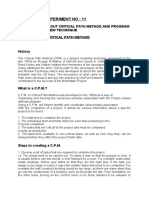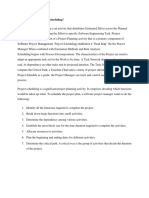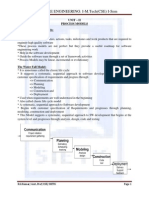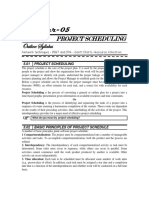Toll Gate 5 ORbs
Toll Gate 5 ORbs
Uploaded by
Pranayaji Munda loharCopyright:
Available Formats
Toll Gate 5 ORbs
Toll Gate 5 ORbs
Uploaded by
Pranayaji Munda loharCopyright
Available Formats
Share this document
Did you find this document useful?
Is this content inappropriate?
Copyright:
Available Formats
Toll Gate 5 ORbs
Toll Gate 5 ORbs
Uploaded by
Pranayaji Munda loharCopyright:
Available Formats
oll Gate 5: Network Analysis Operations Research
Imagine you are leading a project management team responsible for constructing a new office
building for a growing technology company. The project is complex and has multiple phases. You
have created a Work Breakdown Structure (WBS) and identified key project activities. The project's
success is critical to the company's growth and requires efficient management.
Describe how you would apply the Critical Path Method, and Programme Evaluation & Review
Technique to identify the critical path and assess project duration. Include a task in your office
building project that has dependencies and might affect the project's overall timeline.
ANSWERS:-
Applying Critical Path Method (CPM) and Programme Evaluation & Review Technique (PERT) in
Project Management:*
*1. Critical Path Method (CPM):*
- *Objective:* Identify the critical path and determine the project duration.
*Steps:*
a. *Work Breakdown Structure (WBS):* Break down the project into tasks and subtasks.
b. *Task Sequencing:* Determine the sequence and dependencies among tasks.
c. *Activity Duration Estimation:* Estimate the time required for each task.
d. *Forward Pass:* Calculate the earliest start and finish times for each task.
e. *Backward Pass:* Calculate the latest start and finish times for each task.
f. *Float Calculation:* Identify tasks with zero float; these are on the critical path.
g. *Critical Path:* The sequence of tasks with zero float represents the critical path.
h. *Project Duration:* The sum of durations along the critical path determines the project's
minimum duration.
*2. Programme Evaluation & Review Technique (PERT):*
- *Objective:* Provide a probabilistic estimate of project duration considering uncertainties.
*Steps:*
a. *Optimistic, Most Likely, and Pessimistic Estimates:* Gather estimates for each task.
b. *PERT Calculation:* Use the formula \( \text{PERT Estimate} = \frac{\text{Optimistic} + 4 \times
\text{Most Likely} + \text{Pessimistic}}{6} \) to calculate a weighted average for each task.
c. *Network Construction:* Create a network diagram considering dependencies and durations.
d. *Critical Path Determination:* Identify the longest path based on PERT estimates.
e. *Probability Analysis:* Assess the probability of completing the project within a certain duration.
*Example Task with Dependencies:*
Consider the task "Install IT Infrastructure" in the office building project. Dependencies may include:
- Dependency 1: Completion of the construction phase.
- Dependency 2: Delivery and setup of IT equipment.
- Dependency 3: Inspection and approval of the building's electrical systems.
If any of these dependencies is delayed, it will impact the start of "Install IT Infrastructure,"
potentially affecting the overall project timeline. Identifying and managing these dependencies is
crucial for efficient project execution.
By applying CPM and PERT, you gain a comprehensive understanding of the project's critical path,
allowing you to prioritize tasks, allocate resources effectively, and manage uncertainties for
successful project completion.
You might also like
- Iso 27001 Statement of Applicability Ism Not 008Document7 pagesIso 27001 Statement of Applicability Ism Not 008balaji100% (3)
- Spmbit 1Document18 pagesSpmbit 1hamsaavarshinib12No ratings yet
- Spmbit 2Document22 pagesSpmbit 2hamsaavarshinib12No ratings yet
- PajaritoDocument16 pagesPajaritoRoberto AlvarezNo ratings yet
- Topic 8 - Project Management.rDocument23 pagesTopic 8 - Project Management.rCNo ratings yet
- BTCVC 604 Full SolutionsDocument3 pagesBTCVC 604 Full SolutionsMr DevilNo ratings yet
- Project Scheduling - CPM - PERT Module 3Document54 pagesProject Scheduling - CPM - PERT Module 32021.aman.kumarNo ratings yet
- Excercise 2 Chapter 7Document7 pagesExcercise 2 Chapter 7tatamaria15No ratings yet
- Experiment No: 11: Aim: To Study About Critical Path Method and Program Evaluation Review Technique Critical Path MethodDocument20 pagesExperiment No: 11: Aim: To Study About Critical Path Method and Program Evaluation Review Technique Critical Path Method90gaurangNo ratings yet
- Se Lab FileDocument46 pagesSe Lab FilemglotovNo ratings yet
- Need of Project ManagementDocument19 pagesNeed of Project ManagementAnonymous kwi5IqtWJNo ratings yet
- Chapter 4 SE - Software Project PlanningDocument50 pagesChapter 4 SE - Software Project PlanningRojina ShresthaNo ratings yet
- Project Management (To Students)Document62 pagesProject Management (To Students)cv5mv6w4htNo ratings yet
- Work Breakdown StructuresDocument45 pagesWork Breakdown Structuresaswathi1No ratings yet
- Network ModelDocument69 pagesNetwork ModelAbdi NegassaNo ratings yet
- Critical Path Method (CPM) : Project Management For ITDocument23 pagesCritical Path Method (CPM) : Project Management For ITSyed EmadNo ratings yet
- ### Q.3 Attempt Any SIX Questions (Short Answer Type) - Each QuestionDocument5 pages### Q.3 Attempt Any SIX Questions (Short Answer Type) - Each QuestionANSHUL JAINNo ratings yet
- Network ModelsDocument44 pagesNetwork Modelsac.hamuyanNo ratings yet
- Cocomo (Estimation)Document41 pagesCocomo (Estimation)Anonymous zOLgWrGNo ratings yet
- Managing ProjectDocument119 pagesManaging ProjectCharisa SamsonNo ratings yet
- Unit - 2 Software Project SchedulingDocument20 pagesUnit - 2 Software Project SchedulingPrabal Singh JhaNo ratings yet
- Software Project Planning: Infsy 570 Dr. R. OckerDocument50 pagesSoftware Project Planning: Infsy 570 Dr. R. OckerAunbhav SarmaNo ratings yet
- Chapter 5-Project ManagementDocument20 pagesChapter 5-Project ManagementGuenivere FajaritoNo ratings yet
- Project Management Cpm/Pert: Professor AhmadiDocument19 pagesProject Management Cpm/Pert: Professor AhmadiboubkaNo ratings yet
- Unit II (Part B) Activity Planning SYMCA (2024-2025) Sem-IDocument91 pagesUnit II (Part B) Activity Planning SYMCA (2024-2025) Sem-Iadityakatare35No ratings yet
- PM Chapter-5Document18 pagesPM Chapter-5GolamSarwar100% (1)
- Software Engineering: I-M.Tech (Cse) I-Sem: Unit - Ii Process Models Prescriptive Process Models: DefinitionDocument12 pagesSoftware Engineering: I-M.Tech (Cse) I-Sem: Unit - Ii Process Models Prescriptive Process Models: DefinitionrgkumarsietkNo ratings yet
- PM Chapter-5Document18 pagesPM Chapter-5GolamSarwarNo ratings yet
- Tutorial 7Document12 pagesTutorial 7syazwan_badboyzNo ratings yet
- Importance: Importance of Project SchedulesDocument21 pagesImportance: Importance of Project SchedulesAnonymous XybLZfNo ratings yet
- OR Chapter 5Document21 pagesOR Chapter 5anon_92845981No ratings yet
- Project Scheduling: Pert/Cpm: Learning ObjectivesDocument34 pagesProject Scheduling: Pert/Cpm: Learning ObjectivesBert Eng75% (4)
- Practical 2 1Document17 pagesPractical 2 1prince1msbingNo ratings yet
- Unit 4 Project Scheduling: Steps To Developing A Project ScheduleDocument11 pagesUnit 4 Project Scheduling: Steps To Developing A Project ScheduleParul varshneyNo ratings yet
- Critical Path MethodDocument54 pagesCritical Path MethodKenneth Bryan Copino100% (1)
- Chap2 Managing Info Sys ProjDocument30 pagesChap2 Managing Info Sys ProjJessa KhulotNo ratings yet
- TIME ManagementDocument7 pagesTIME ManagementAhmed AbdelrahmanNo ratings yet
- UNIT 2 Software Project PlanningDocument60 pagesUNIT 2 Software Project Planningjagtapsangharsh0007No ratings yet
- Software Project SchedulingDocument31 pagesSoftware Project Schedulingsuryavamshirakesh1No ratings yet
- Network Analysis - FinalDocument43 pagesNetwork Analysis - FinalRaheel SultanNo ratings yet
- Construction Engineering & ManagementDocument10 pagesConstruction Engineering & ManagementRitwik PaulNo ratings yet
- Critical Path Method SchedulingDocument4 pagesCritical Path Method SchedulingLucky EdjenekpoNo ratings yet
- Operations Management - Lesson 6Document53 pagesOperations Management - Lesson 6Thomas IsoaNo ratings yet
- Critical Path MethodDocument2 pagesCritical Path MethodjuniordarylNo ratings yet
- BSBPMG531 AssessmentDocument6 pagesBSBPMG531 Assessmentthank pinhNo ratings yet
- Project Time and Cost EstimationsDocument7 pagesProject Time and Cost EstimationsaliasgharspamNo ratings yet
- Definition and Why Project Network EssentialDocument40 pagesDefinition and Why Project Network EssentialswamibagNo ratings yet
- Multimedia Making It Work by Tay Vaughan (301-350)Document50 pagesMultimedia Making It Work by Tay Vaughan (301-350)lekupaleNo ratings yet
- Project Management Unit 2 Lecture 2.9Document31 pagesProject Management Unit 2 Lecture 2.9tanya sharmaNo ratings yet
- CM Week 13-14Document23 pagesCM Week 13-14Muhammad AzharNo ratings yet
- Software Eng. NotesDocument61 pagesSoftware Eng. Notesvivek99397345No ratings yet
- SPM Ass 2 Imp Ques and AnswersDocument19 pagesSPM Ass 2 Imp Ques and AnswersDJ editzNo ratings yet
- Network Analysis Precedence Diagram and Scheduling ComputationDocument16 pagesNetwork Analysis Precedence Diagram and Scheduling ComputationhmjrfnwcckNo ratings yet
- Unit 3 PMDocument25 pagesUnit 3 PMNantenin MagassoubaNo ratings yet
- Module 3 Project Scheduling, Monitoring & Risk ManagementDocument13 pagesModule 3 Project Scheduling, Monitoring & Risk Managementhanif malgundkarNo ratings yet
- Project Planning Techniques Network Analysis Critical Path Method (CPM)Document8 pagesProject Planning Techniques Network Analysis Critical Path Method (CPM)Hilary WatsonNo ratings yet
- CISA Exam-Testing Concept-PERT/CPM/Gantt Chart/FPA/EVA/Timebox (Chapter-3)From EverandCISA Exam-Testing Concept-PERT/CPM/Gantt Chart/FPA/EVA/Timebox (Chapter-3)Rating: 1.5 out of 5 stars1.5/5 (3)
- Earned Value Project Management (Fourth Edition)From EverandEarned Value Project Management (Fourth Edition)Rating: 1 out of 5 stars1/5 (2)
- Introduction to Project Management: The Quick Reference HandbookFrom EverandIntroduction to Project Management: The Quick Reference HandbookNo ratings yet
- The TOGAF® Standard, 10th Edition – Architecture Development MethodFrom EverandThe TOGAF® Standard, 10th Edition – Architecture Development MethodNo ratings yet
- The Literature Review Lawrence MachiDocument5 pagesThe Literature Review Lawrence Machidazelasif100% (1)
- Arda Journal 16656Document15 pagesArda Journal 16656valeriangift4No ratings yet
- DS-2CD2T46G1-4I'SL Datasheet V5.5.72 20190610Document5 pagesDS-2CD2T46G1-4I'SL Datasheet V5.5.72 20190610Anjar HaulaNo ratings yet
- 2013 - SIGMOD - Moerkotte - Correct and Complete Enumeration of Search SpaceDocument12 pages2013 - SIGMOD - Moerkotte - Correct and Complete Enumeration of Search SpaceNing LiangNo ratings yet
- Baumer 2VT DS 1208Document2 pagesBaumer 2VT DS 1208BillwallaNo ratings yet
- Info On Paver BlocksDocument6 pagesInfo On Paver BlocksGaneshNo ratings yet
- Exercise Workbook For Student 11: SAP B1 On Cloud - AISDocument37 pagesExercise Workbook For Student 11: SAP B1 On Cloud - AISRynette FloresNo ratings yet
- FL Studio Tutorial - How To Create Impressive Piano Flourishes in FL StudioDocument13 pagesFL Studio Tutorial - How To Create Impressive Piano Flourishes in FL StudioPalanisamy BalasubramaniNo ratings yet
- Corporate: Corporate Manual Project ManagementDocument26 pagesCorporate: Corporate Manual Project ManagementpqmshxyuswvglefspiNo ratings yet
- Chapter OneDocument22 pagesChapter OneDesyilalNo ratings yet
- Taking HART... : Har-TbusDocument2 pagesTaking HART... : Har-TbusAugust CruzNo ratings yet
- PHD BrochureDocument18 pagesPHD Brochuresourav gangulyNo ratings yet
- Evidence PlanDocument11 pagesEvidence PlanJestoni CenizaNo ratings yet
- Assignment EE1130 - Abu Ubaidah Amir Bin Abdul AzizDocument24 pagesAssignment EE1130 - Abu Ubaidah Amir Bin Abdul AzizAbu UbaidahNo ratings yet
- Review of Related LiteratureDocument10 pagesReview of Related LiteratureJhansen Feliciano /JHAZPRINT/No ratings yet
- PM Debug InfoDocument92 pagesPM Debug InfoMihai cosminNo ratings yet
- Resume Format 3 - 2columnDocument1 pageResume Format 3 - 2columnFarhan khanNo ratings yet
- Operating Manual - AGM-13HDocument181 pagesOperating Manual - AGM-13HAshby KbNo ratings yet
- 04 Dev275 s00Document10 pages04 Dev275 s00Vishnu PatidarNo ratings yet
- TeSys Control Relays - CA2KN22U7Document3 pagesTeSys Control Relays - CA2KN22U7Ban Juan OoiNo ratings yet
- 1470 Sas 2Document2 pages1470 Sas 2tallervaleras2020No ratings yet
- Elementary Transformations of A Matrix and Gauss Jordan Method To Find InverseDocument8 pagesElementary Transformations of A Matrix and Gauss Jordan Method To Find Inverseasfvkjsv asgbaegbNo ratings yet
- DBMS Final Exam (1) 147-166Document20 pagesDBMS Final Exam (1) 147-166Sriharsha BNo ratings yet
- 3 2systems AlgDocument20 pages3 2systems AlgSyeda Saman Zahra Zaidi/TCHR/GBFNo ratings yet
- Simatic Net PG/PC - Industrial Ethernet CP 1623Document22 pagesSimatic Net PG/PC - Industrial Ethernet CP 1623Oleksandr BeketovNo ratings yet
- User'S Guide: Refrigerant RecyclerDocument48 pagesUser'S Guide: Refrigerant RecyclerAdy Jr.No ratings yet
- JJRZ60-6.18HP: Data SheetDocument2 pagesJJRZ60-6.18HP: Data SheetJamyansuren TseveendorjNo ratings yet
- Alphatronic 3000Document2 pagesAlphatronic 3000Johan JosueNo ratings yet
- Manual Book HERMAX - SLD500Document4 pagesManual Book HERMAX - SLD500Bambang PriyambodoNo ratings yet

























































































